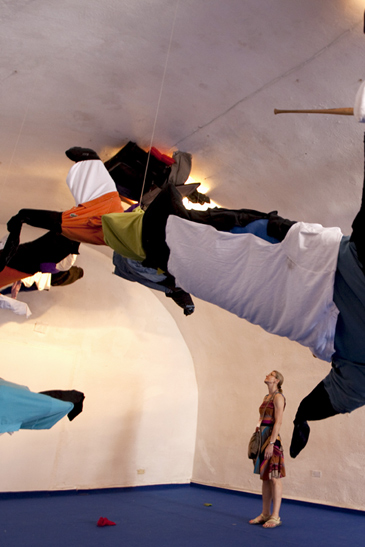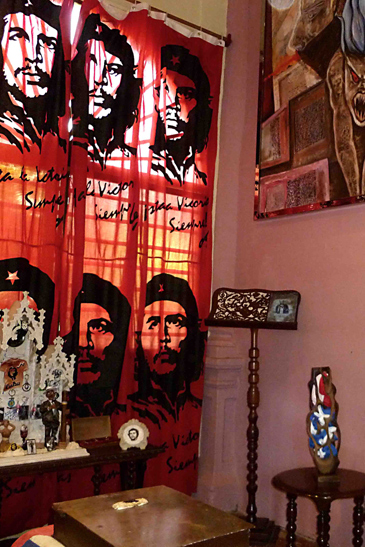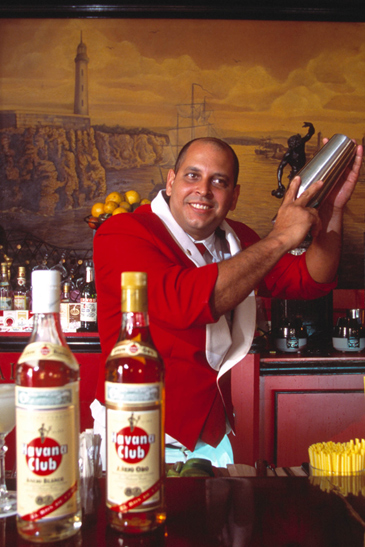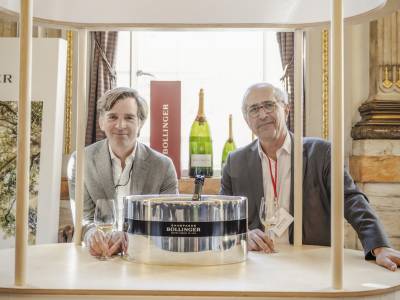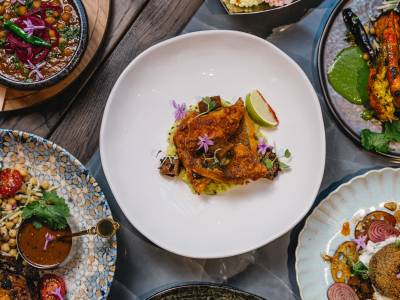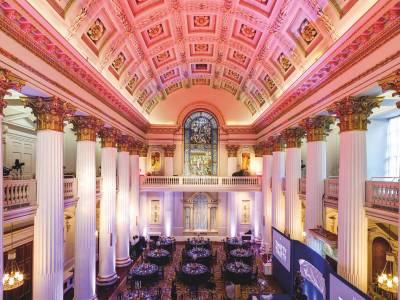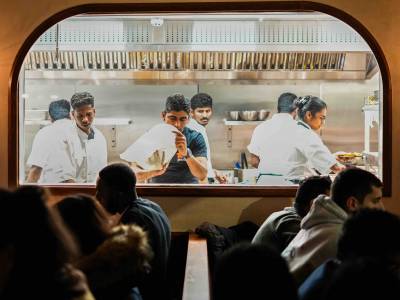Global media was abuzz in January with the news that Fidel Castro had made his first public appearance in almost a year. What roused the former Cuban president to leave the house? The opening of Studio Kcho Romerillo Laboratory for Art, a new gallery in Havana, run by acclaimed artist Alexis Leiva Machado (known to Cubans as simply “Kcho”).
Cuban cool: Havana's growing art scene
15th March 2013
There is more to Havana than communism, old Chevrolets and cigars. Lydia Bell gains a different perspective during a unique tour of the artists and galleries that give Cuba’s dynamic capital its soul
As Kcho’s career illustrates, art plays an important part in Cuban life. His acclaimed monumental sculptures, installations and paintings, which use pieces of boats, propellers, driftwood and nets to evoke life as an islander, are seen overseas as a critical commentary on Cuba’s internal realities. At home, he is a revered figure, who established a “brigade” of artists and performers to bring art to the masses, and became deputy of the Popular Power National Assembly, Cuba’s legislative parliament. On the gallery’s opening night, Castro gave him a book inscribed: “To Kcho, for the nobleness with which you have lived your life and the happiness you’ve given us.” Just a month later, hip-hop and afro-rock musician X Alfonso unveiled Fábrica de Arte Cubano (FAC) with a live gig. This public-private project is an astounding space for making cinema, theatre, dance, music, literature, fashion, architecture, graphic design, photography and the visual arts. Both this multimedia venue and Kcho’s gallery signify exciting times for the Cuban art scene—openings of new spaces are as rare as hen’s teeth—and distil the Cuban wish to bring art to everyone. Studio Kcho Romerillo Laboratory for Art hosts exhibitions, and children’s and graphic workshops, as well as a museum and community theatre. Fábrica de Arte Cubano has future plans for a community library, street projects and a programme of workshops to upskill the local neighbourhood. You easily could come to Havana and enjoy the perfectly decent, government-run galleries, or its next Biennial in 2015 (after which it becomes a Triennial). But the most exciting way to experience Havana’s culture is by meeting its artists. To do this you need an entrée, and that’s where Sussette Martinez comes in. Whether you want a crash course in Cuban art, access to private collections, to discover who’s hot and who are the under-the-radar artists, Sussette has her tentacles everywhere.
We visit Ibrahim Miranda, an internationally exhibited printmaker known for “internal cartography”. His work includes printing Spanish maps in strips, superimposed with patterns and talismans that comment on social issues, race and identity. These fragile flapping works sell like hot cakes. An obsession with islands, maps and geography is a facet of being Cuban, he says: “Migration is quotidian, for us.” Cuba has a population of some 11 million, but there are one million Cubans in exile. Feelings of alienation and abandonment are part of the country’s condition, whether you have stayed or left. Miranda was born in 1969, and came of age in the 1990s when a large number of his contemporaries left; in one piece, he has drawn a map of Cuba decorated with the place where his departed friends now live. In another, he decorates photographs of Havana with black-market lottery numbers. It sings with a feeling of being jettisoned to parochialism. An artist called “Memo” takes me frenetically through his latest work: a series of white-on-white and black-on-black paintings. They convey dissatisfaction in a roundabout way; it’s hard to see the paintings altogether. One depicts ET in transit over Havana, an allusion to the perpetual dream of migration. In another, cartoon character Elpidio Valdés, a Cuban freedom-fighter, has left his machete in the ground and is coquetting with Betty Boop. Memo’s real name is Raúl Castro, the same as the Cuban president. Ironically, past installations include a bowling game with Fidel as a giant skittle impossible to topple.
We get lost in Cerro, a barrio off the beaten track for tourists. A huge group of boys is playing baseball outside Samuel Reira’s studio. This talkative, bearlike man is a printmaker, painter, video artist and collaborator. His Riera Studio works with a group of about 50-odd Cuban artists. Another connection with Parisian gallerist Christian Berst has led to an unusual project that he calls “El Museo de Arte Maníaco” (the Museum of Insane Art). The studio space bursts with transcendental pieces of art, which have been made by the mentally ill. A deaf-mute girl with cerebral dysrhythmia produces intense pictures of musclebound men; a young schizophrenic man fashions life-size cartoon characters from discarded wood. A visit to the collector José Busto takes us to the Santos Suarez neighbourhood, where raggedy, bourgeois, early 20th-century homes line quiet roads laced with potholes. Earnest, pale and suited, he occupies a worn-down gilded sofa in a room filled with elaborate Spanish glassware and urns competing with a massive Carlos Quintana canvas. The house has an eternal, congealed air. Unchanged 1940s interiors—the stuff of many a coffee-table book—are par for the course in Cuba, but the famous Cuban noisiness normally breaks the spell.
Here, the clock ticks loudly on the wall. The rooms are crammed with work by contemporary artists: Roberto Fabelo, Fidel Yordán Castro, Yoan and Ivan Capote, Lidzie Alvisa. In the kitchen, lines of pegged-out washing obscure the canvases. In other rooms, antiques (Busto also collects and sells engravings, glass, miniatures, porcelain, ceramics and jewellery from Cuba, Europe and Asia) compete with objects of daily life. This is something you see in every collector’s or artist’s home: the extended family in the background; the art above the microwave; the baby’s plastic bouncer next to works by famous names. Busto is a patron with an unnerving passion for his pieces. Isla Pertenencia, a Yoan Capote work that was part of a series I first saw in a London gallery in Shoreditch in 2008, hangs in the front room. It’s a painting of the sea that at first appears merely beautiful; when you look closer, you see that fish hooks form the darkness in the waves. It’s a reflection on Capote’s childhood longing to know what lay beyond that horizon, and its impenetrability. Busto was so enamoured of the piece, he followed it from conception to realisation; drops of his own blood were used to give the warming rosy tone. Busto’s prodigy went far: he just closed a solo exhibition at Ben Brown in London. Busto had a dream, which he realised briefly—to open an independent gallery in Havana. Avistamientos on Calle E in Vedado devoted itself to championing emergent artists, and nine of his 11 prodigies made it to the 2012 Biennal. But the owners pulled the lease after a year-and-a-half. For now, he has migrated his works across the road. We find his neighbour in a housedress mopping the floor, her walls lined with works by top artists.
Some artists circumvent the galleries. I came across the work of Amarilys González and Yailyn González, also known as Plastic Guajiras, at Le Chansonnier, my favourite restaurant in Havana. Suspended from the ceiling was a jellyfish-like installation made from scores of blue plastic bottles, tentacles suggested by the trailing fabric dripping from them; the light refracting off the plastic. Amarilys and Yailyn rail against the Barbie-doll culture imposed on Cuban women. It’s a macho society, Amarilys tells me, and no one is more macho than women. Through amusing video art, they fight back against the culture that produces the quince años, which sees 15-year-olds celebrate their “coming of age” with a photoshoot, expensive party, frilly wedding-style dress and lashings of make-up. Amarilys shows me robust examples of her work: her and her girlfriends running a relay with a dildo as a baton; playing dominoes—the ultimate Cuban male pastime—in their bras; working on a building site in quince años dresses; and the hands of a man using a naked female crotch as a drum. In another video, the Plastic Guajiras scale the cupola of an abandoned arts school building, tearing off their clothes as they ascend, forming a circle at the top and then urinating in unison. Everyone claps. (I have to confess, the explanation of this one was lost in translation.)
Finally, I encounter a couple of art-loving foreigners who have adopted Havana and made it their home. Portuguese architect Carlos Ferreira de Vita has renovated one of the best houses in Miramar and filled it with Cuban art. His collection spans the unmistakable erotic sketches of Fabelo, the intense body photographs of René Peña, and the iconic recycled pieces of the Afro-Cuban superstar Roberto Diago. Together with his partner Michel Núñez, who runs tailor-made travel outfit Cuba Privilege, they introduce visitors to the most important 1950s houses in Havana, and give them a taste of electrifying Cuban art. Art curator Pamela Ruiz has produced Louise Bourgeois and Robert Mapplethorpe retrospectives on the island. Her house with artist husband Damián Aquiles is a receptacle for his work, ranging from abstract canvases to collages and sculptures made from found metal, which has been exhibited around the world. The home—beautiful enough to be a film set—has a rough glamour that is always part way to being renovated. It’s hard to know what came first, the home or the art, as the relationship is symbiotic. Lively and hospitable, Ruiz is adept at “cultural translation”, working by referral only to curate meaningful encounters within the art world.
Having had so many meaningful encounters myself, I leave Havana filled with a sense of astonishment at so much riveting, original, impassioned art. It’s full of oblique polemic, but then so is all of Cuba. Flora Fairburn, a British curator who works as a consultant for the cultural website havana-cultura.com, cites the lack of access to the internet as a key factor in producing a personal, uniquely evolved art. It’s true. For me the art, like the island itself, is always revealing, making the rest of our hyper-globalised world seem that much more ersatz by comparison. WHERE TO BOOK, STAY, EAT & DRINK TOURSCazenove + Loyd (020 7384 2332; www.cazloyd.com) offers tailor-made holidays to experience Cuba, including in-depth art tours.
STAY At Suite Havana (book through Cazenove + Loyd), a two-bedroom apartment in the Old Town, which has a marble staircase, five balconies and art by Wifredo Lam, Julio Girona, Zaida del Rio and Choco. EAT The restaurant scene is on fire as Cuba loosens up. Le Chansonnier (Calle J #257 between 15 & Línea, Vedado) is a colonial home adorned with revolving installations. Try reimagined Cuban classics and interesting mezze such as rabbit terrine. Starbien (Calle 29 #205, between B & C, Vedado) is a colonial mansion that celebrates Cuban and exotic fare: paella negra and swordfish teriyaki. Atelier(Calle 5 between Paseo & 2, Vedado) is a 16th-century house and rooftop, its interiors enlivened with art, with a fusion menu of duck confit, octopus carpaccio and filet mignon (but menus change daily). DRINK New bars open weekly. The best is El Cocinero (Calle 26 between 11 & 13, Vedado, La Habana), next to X Alfonso’s Fábrica de Arte Cubano. It’s the alfresco rooftop space of a factory. Privé Lounge (Calle 88A #306, between 3ra & 3raA, Miramar) is Havana’s first private music club, which has a stellar line-up, from jazz legend Michel Herrera to nueva trova star Frank Delgado.
GETTING THERE
Virgin Atlantic fly twice weekly to Havana from London Gatwick. www.virgin-atlantic.com
Credits: Mark Read; Associated Press; Kcho Studio, Courtesy of cubanartnews.org; New York Times/Redux/Eyevine; Getty; Cazenove & Loyd; Courtesy of Yai González; Courtesy of Yoan Capote; Courtesy of René Peña

